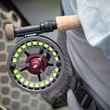Recently I spent a day testing new rods for one of the domestic rod companies. As I was casting in my local park, a fishing friend stopped by to see what I was up to. Naturally, I invited him to give the rods a try, curious as to what he would think. After casting one rod in particular he got pretty excited, gushing to me about the high line speed he had achieved with it. I replied that, unfortunately, high line speed was all that that particular rod could achieve. He shot me back a quizzical look, one that I knew required further explanation.
For quite some years, high line speed has been held in—forgive me here—high regard. Something like a Holy Grail for those who evaluate fly rods. Rods judged to produce high line speed are much feted. Rods that don’t are considered substandard. But here’s the thing. In most fishing situations where trout are involved, we don’t need high line speed. In fact, it can actually be a disadvantage, even downright dangerous. Think about casting a couple nymphs, split shot and an indicator. That’s not the kind of setup you want whizzing back and forth alongside your head at high speed.
Ideally, a fly rod should allow us to deliver our fly to its target using the lowest possible line speed commensurate with getting the job done. It’s a simple question of efficiency, really. Employing a higher than necessary line speed is wasteful, requiring more work of the caster. Sort of like riding a bicycle with the brakes perpetually applied. You can do it, but it takes more effort and isn’t nearly as much fun.
A brute fact about contemporary rods is that many of them aren’t capable of being cast with anything but high line speed. How’s that, you ask? Well, consider how a fly rod functions. When a rod bends, it stores energy. When it straightens out, that energy is delivered back into the cast, helping to propel the line. The more a rod bends of its own design, the more energy it stores (thus requiring less from the caster). The more resistant a rod is to bending—meaning stiffer—the more work required to force it to bend, to store the necessary energy. More work from the caster means one thing—more acceleration of the arm and hand. The consequence of this acceleration is higher line speed.
Indeed, casting a stiff rod requires a faster, more energetic casting stroke. (If you doubt the veracity of this concept, string a line up on a rigid dowel and cast it. You’ll immediately see what I’m talking about.) An overly stiff rod is exactly what my friend was casting when he exclaimed about how much line speed he was achieving. Damn right he had high line speed—it was the only possible outcome from that rod.
I believe that fly casting should be a pleasurable, rewarding experience. Done particularly well, it’s a pursuit both graceful and elegant (even when casting weighted flies). Ignoring or downplaying these aesthetic values begs the question, why fly fish at all? To this end, a well-designed rod provides great aesthetic rewards. One hallmark of such a rod is that it allows for the use of any line speed deemed appropriate by the caster—high, low, anything in between. A good rod never dictates the line speed with which it must be cast; it merely responds to the desires and needs of the caster.
Low line speed requires low physical effort, and for most folks yields maximum casting enjoyment. It certainly does for me, which is why for any given situation—freshwater, saltwater, anything—I’m always searching for the lowest line speed I can employ. But there are other reasons for casting a slow line beyond concerns about aesthetics and effort. A slowly moving line is easier to control. Pinpoint accuracy is easier to achieve. Yes, there are times when high line speed is necessary—think long distance casting or dealing with big wind—but in most trout fishing those are unusual circumstances.
I feel fortunate to own a few rods that allow me to cast comfortably at any line speed I choose. They’re older rods, dating back to the late ’70s and early ’80s, rods that bend easily under their given line weight. That kind of rod is harder to come by these days, but lately several rod companies have begun making new forays in this direction. That’s great news, since it will offer many anglers their first chance to experience full control of their own line, on their own terms.
I suspect they’ll find that to be a lot of fun.































Comments
Todd Tanner replied on Permalink
This is a great piece on rod design and casting, from a truly exceptional angler. I'm stoked that so many manufacturers are moving back towards more moderate action rods - but this story should still be required reading for every serious rod designer. John hits the nail squarely on the head with this one.
Marty Howard replied on Permalink
We for years have called them "parking lot rods". Easy sell, because someone not proficient in casting a fly rod, can for the most part, cast farther with a fast action rod. Once you learn how to cast, line speed is created by the left hand, more so than the rod. There are times when a fast action rod is needed, but as with you, I fish progressive action rods. The old G Series Scott, The old Orvis rods and anything built on a Fisher blank, are my rods of choice. But when I want slow I fish glass and cane. Feels like things are coming full circle. Great read, you nailed it.
Matt Reilly replied on Permalink
You got it right in this one! I've been working with Tycoon Tackle, a Virginia-based fly rod manufacturer, in building their product arsenal, and one of the things we are fighting is the industry's propaganda that touts fast-action rods that deliver laser line speeds. Such tapers, to me, are not what a fly rod should be about, and they make the guide's job a hell of a lot harder in teaching people the skill and mechanics of the fly cast. Slower rods make instinctual casting easy, and that's what puts fish in the boat!
Casey replied on Permalink
So glad someone has said this. It's 100% truth that only a small few truly understand. A+
Bud Crist replied on Permalink
John, you nailed it! At last an essay on rods and casting that gets it right. There are a lot of situations that require high line speed, but it needs to be my choice and not dictated by the rod. I love watching a loop gracefully roll out with just enough energy to reach the target and settle to the water.
Alyssa Halls replied on Permalink
Good read! Faster is definitely not always better. This gave some thoughts I've had a little scientific clarity. Thanks for the insight.
Jim replied on Permalink
I totally disagree. If you're a good caster, you can make a stiff, extra fast action rod work. Those types of rods give you a better range and a lot more room to adjust to many different fishing situations. By just changing the fly line, you change the action of the rod. You can never make a slow rod fast, it can only be done the other way around. You guys are totally wrong, each rod has it's own personality. Matched with an appropriate fly line and it casts beautifully. If you tried to dictate how the rod should cast, you've just failed to properly cast. A slow rod requires you to have a relaxed stroke, a fast rod requires you to react quicker. You're only choice is changing out the line to slow it down, especially at close fishing ranges. You adjust your stroke based on the setup. Don't believe me? Try it yourself.
Steve Bossi replied on Permalink
Could not agree more. Good article and, I think, hits a great point. Faster is not always better. I still get great enjoyment out of my old Sage SLT rods and the newer Circa rod as well. There are time the very old XP is called for but that is infrequent at best.
ECHO MAN replied on Permalink
This is a cool article on line speed and fly rod design. John should be thanked for bringing the topic to the table. As a rod designer I think it is important to know how far a person wants to cast, how big the fly is (wind resistant), how much wind you want to cast into, and how much power you need to fight a fish. I consider all these factors when designing a rod. The factors that don’t get much attention is how hard do you want to work to make a cast. There was a comment made to John's article that implied “any stiff rod can present a fly with low line speed” which I would fundamentally agree with. You can take a 5 weight line and put it on an 8 weight rod and throw a delicate 30 foot cast with low line speed. We use to practice making dry fly presentations to targets with a stiff rod as a way to prepare for tournament dry fly accuracy competition.
The bummer is that to make a short cast with a nice loop shape using an overly stiff rod your hand would likely only move a few inches (maybe 3 to 6 inches) and the casting movement would have to be abrupt and agressive. Could it be done…..&$*@ yeah you can do it, but you would not have much fun fishing like that all day. We fish for fun and I think a smooth casting motion with modest acceleration should reward the caster with a nice loop of modest line speed. A rod with modest action, and more importantly modest stiffness, would likely be very versatile but is not very "sexy". Someone commented that their favorite rods for lower line speed came from the 1970s and 1980s. It has been my experience that unless you need to cast far, use a long rod, or you are casting heavy lines you don’t benefit fully from the latest high modulus carbon fibers and your “good old rod” will be just fine. I say vive la différence. We are all built different and have different casting strokes and body types and shouldn’t necessarily use the same rod. Some of our bestselling rods are fiberglass and I love fishing glass specifically because I can make a “normal” casting stroke and the rod talks to me and generates a little less speed. John has done a great job of opening our eyes to those than fish slow. Many thanks. TR
Jason M replied on Permalink
I enjoyed this. There was a complementary article on Fly Life Mag. http://flylifemagazine.com/opinion-teaching-if-you-hand-them-a-fast-acti... that discussed teaching and using a slow rod. I have been teaching my 6 year old how to cast and I eventually settled on a "slow" Cabelas rod that was also significantly shorter so she could actually handle the rod.
I fish salt almost exclusively and I first noticed the benefits of a slower rod fishing dock lights for snook. At the time the RPLX or RPLXi was state of the art and I noticed that the high line speed spooked the fish. I started using my first rod a Sage Discovery and it helped land the fly in a bit quieter.
Yes all of this could be accomplished by slowing the stroke down but I think it is worth knowing that there are different tools for the job.
GB replied on Permalink
There is no right or wrong answers with fly fishing, that’s what makes fly fishing so much fun. What works for you and your fishing situations may not work for me, or perhaps, what you prefer to use may not work for me either. In either case, it’s always fun to own and use different pieces of gear. In my case, when I want to feel more of the fight from a fish, I usually grab my glass rod. Nothing beats, watching that glass rod bend way down on a big fish on lighter tippet. I’m actually quite confident with using lighter tippet on glass rods. When I feel like bombing some casts, I usually go for my two-handed graphite rod. That’s a lot of fun watching line just shoot way out across the river. I could do that all day too, especially with a longer belly line and making those wonderful snake rolls. This was a good read, like the other articles. Tight lines!
George M Semel replied on Permalink
Well I bought most all my rods in the 1960's 70's and early 80's! My favorite trout fishing rod is a Sage RP II 8'6" for a five weight line- I just love fishing with it and have done so since I bought it over 30 years ago! When I had to send it back to Sage for a minor repair, reel seat problem, I thought I would be with out it for the bulk of the season, so I bought another Sage an 8'6" RP III five weight, I fished it for about a week, it was way to stiff compared to the RP II! Sage got my rod back to me in less than 10 days! That RP III I didn't fish it much after that till by accident I took it on a trip and the only reels I had in the bag was for a 6 weight rod! That RP-III 5 weight dose what the RP -II did but with a heavier line its really a 6 weight or 6 and a half weight rod not a five! I like it for double nymph rigs with shot and a indicator fishing and light streamer work! You are right, rods today are more for casting in the parking lot than for actual fishing- its a compeative market place to a market that is not very big! And the other thing all my rods are two piece, those seem to have gone out of favor these days!
jon replied on Permalink
Great read. I have almost felt sick in the head for leaving some of my newer more expensive rods in the closet while I fish with my older rods, some purchased when I first tried the sport at garage sales and pawn shops. You just helped me figure out why with this article. Thanks great read.
Pages